This checkin to GC97WM3 3 BH reflects a geocaching.com log entry. See more of Dan's cache logs.
This morning’s caching expedition just has it in for my back, I fear, with this one no exception. Nonetheless, a QEF in the first place I looked. TFTC!
This checkin to GC97WM3 3 BH reflects a geocaching.com log entry. See more of Dan's cache logs.
This morning’s caching expedition just has it in for my back, I fear, with this one no exception. Nonetheless, a QEF in the first place I looked. TFTC!
This checkin to GC97WKD 2 BH reflects a geocaching.com log entry. See more of Dan's cache logs.
A nonprofit I volunteer with has, years ago, held our Christmas bash at the nearby Fairlawns Hotel. We haven’t been in several years and – even though we missed Christmas itself by a full month! – decided to return here this year.
I’m often an early riser, especially when away from home, and enjoy making the most of the first light with a walk. Last time I was here there wasn’t a geocache in sight, so imagine my delight to find that now there’s one right on the doorstep! Armed with a torch to fight off the renaming pre-dawn darkness, I braved the cold and came out to explore.
Found the obvious hiding spot quickly, but my sore back (Fairlawns’ mattress was somewhat softer than I enjoy!) made retrieval challenging! Still, a success once I was on my hands and knees! TFTC, and Merry Christmas I guess!
The two most important things you can do to protect your online accounts remain to (a) use a different password, ideally a randomly-generated one, for every service, and (b) enable two-factor authentication (2FA) where it’s available.
If you’re not already doing that, go do that. A password manager like 1Password, Bitwarden, or LastPass will help (although be aware that the latter’s had some security issues lately, as I’ve mentioned).

I promised back in 2018 to talk about what this kind of authentication usually1 looks like for me, because my approach is a little different:

I simply press my magic key combination, (re-)authenticate with my password safe if necessary, and then it does the rest. Including, thanks to some light scripting/hackery, many authentication flows that span multiple pages and even ones that ask for randomly-selected characters from a secret word or similar2.

My approach isn’t without its controversies. The argument against it broadly comes down to this:
Storing the username, password, and the means to provide an authentication code in the same place means that you’re no-longer providing a second factor. It’s no longer e.g. “something you have” and “something you know”, but just “something you have”. Therefore, this is equivalent to using only a username and password and not enabling 2FA at all.
I disagree with this argument. I provide two counter-arguments:
1. For most people, they’re already simplifying down to “something you have” by running the authenticator software on the same device, protected in the same way, as their password safe: it’s their mobile phone! If your phone can be snatched while-unlocked, or if your password safe and authenticator are protected by the same biometrics3, an attacker with access to your mobile phone already has everything.

2. Even if we do accept that this is fewer factors, it doesn’t completely undermine the value of time-based second factor codes4. Time-based codes have an important role in protecting you from authentication replay!
For instance: if you use a device for which the Internet connection is insecure, or where there’s a keylogger installed, or where somebody’s shoulder-surfing and can see what you type… the most they can get is your username, password, and a code that will stop working in 30 seconds5. That’s still a huge improvement on basic username/password-based system.6
Note that I wouldn’t use this approach if I were using a cloud-based password safe like those I linked in the first paragraph! For me personally: storing usernames, passwords, and 2FA authentication keys together on somebody else’s hardware feels like too much of a risk.
But my password manager of choice is KeePassXC/KeePassDX, to which I migrated after I realised that the plugins I was using in vanilla KeePass were provided as standard functionality in those forks. I keep the master copy of my password database encrypted on a pendrive that attaches to my wallet, and I use Syncthing to push secondary copies to a couple of other bits of hardware I control, such as my phone. Cloud-based password safes have their place and they’re extremely accessible to people new to password managers or who need organisational “sharing” features, but they’re not the right tool for me.
As always: do your own risk assessment and decide what’s right for you. But from my experience I can say this: seamless, secure logins feel magical, and don’t have to require an unacceptable security trade-off.
1 Not all authentication looks like this, for me, because some kinds of 2FA can’t be provided by my password safe. Some service providers “push” verification checks to an app, for example. Others use proprietary TOTP-based second factor systems (I’m looking at you, banks!). And some, of course, insist on proven-to-be-terrible solutions like email and SMS-based 2FA.
2 Note: asking for a username, password, and something that’s basically another-password is not true multifactor authentication (I’m looking at you again, banks!), but it’s still potentially useful for organisations that need to authenticate you by multiple media (e.g. online and by telephone), because it can be used to help restrict access to secrets by staff members. Important, but not the same thing: you should still demand 2FA.
3 Biometric security uses your body, not your mind, and so is still usable even if you’re asleep, dead, uncooperative, or if an attacker simply removes and retains the body part that is to be scanned. Eww.
4 TOTP is a very popular mechanism: you’ve probably used it. You get a QR code to scan into the authenticator app on your device (or multiple devices, for redundancy), and it comes up with a different 6-digit code every 30 seconds or so.
5 Strictly, a TOTP code is likely to work for a few minutes, on account of servers allowing for drift between your clock and theirs. But it’s still a short window.
6 It doesn’t protect you if an attacker manages to aquire a dump of the usernames, inadequately-hashed passwords, and 2FA configuration from the server itself, of course, where other forms of 2FA (e.g. certificate-based) might, but protecting servers from bad actors is a whole separate essay.
This is a repost promoting content originally published elsewhere. See more things Dan's reposted.
…
If you read a lot of the “how to start a blog in 2023” type posts (please don’t ever use that title in a post) the advice will often boil down to something like:
- Choose a niche
- Start collecting email addresses immediately (newsletter)
- Write on a regular schedule
I don’t do any of those things. 😂
…
Kev writes about what he’s learned from ten years of blogging. As a fellow long-term blogger1, I was especially pleased with his observation that, for some (many?) of us old hands, all the tips on starting a blog nowadays are things that we just don’t do, sometimes deliberately.
Like Kev, I don’t have a “niche” (I write about the Web, life, geo*ing, technology, childwrangling, gaming, work…). I’ve experimented with email subscription but only as a convenience to people who prefer to get updates that way – the same reason I push articles to Facebook – and it certainly didn’t take off (and that’s fine!). And as for writing on a regular schedule? Hah! I don’t even manage to be uniform throughout the year, even after averaging over my blog’s quarter-century2 of history.
Also like Kev, and I think this is the reason that we ignore these kinds of guides to blogging, I blog for me first and foremost. Creation is a good thing, and I take my “permission to write” and just create stuff. Not having a “niche” means that I can write about what interests me, variable as that is. In my opinion the only guide to starting a blog that anybody needs to read is Andrew Stephens‘ “So You Want To Start An Unpopular Blog”.
And if that’s not enough inspiration for you to jump back in your time machine and party like the Web’s still in 2005, I don’t know what is.
1 I celebrated 20 years… a while back?
2 Fuck me, describing a blog as having about a quarter-century of history makes it sound real old.
Two years after our last murder mystery party, almost three years since the one before, and much, much longer since our last in-person one, we finally managed to have another get-the-guests-in-one-place murder mystery party, just like old times. And it was great!

It’s still been been over a decade since we played a mystery that I wrote (though I’m hoping to rectify that within the year): this time we played D’Avekki Studios‘ Murder in the Library.
D’Avekki’s murder mystery sets use an unusual mechanic that I’ve discussed before online with other murder mystery party authorship enthusiasts1 but never tried in practice: a way of determining at random who the murderer is when play begins. This approach has a huge benefit in that it means that you can assign characters to players using a subset of those available (rather than the usual challenges that often come up when, for example, somebody need to play somebody of a different gender than their own) and, more-importantly, it protects you from the eventuality that a player drops-out at short notice. This latter feature proved incredibly useful as we had a total of three of our guests pull out unexpectedly!
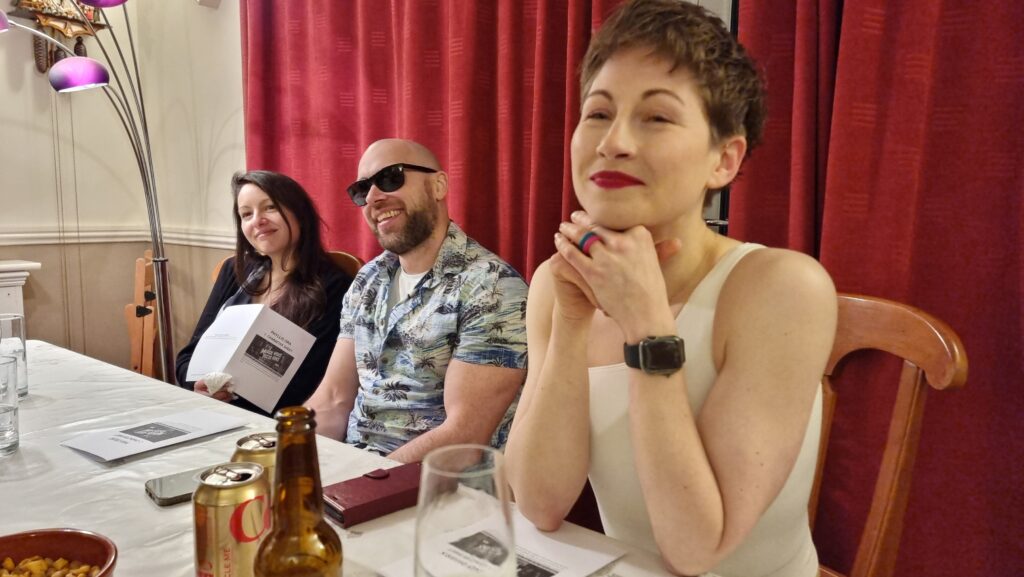
The challenge of writing a murder mystery with such a mechanic is to ensure that the script and evidence adapt to the various possible murderers. When I first examined the set that was delivered to us, I was highly skeptical: the approach is broadly as follows2:
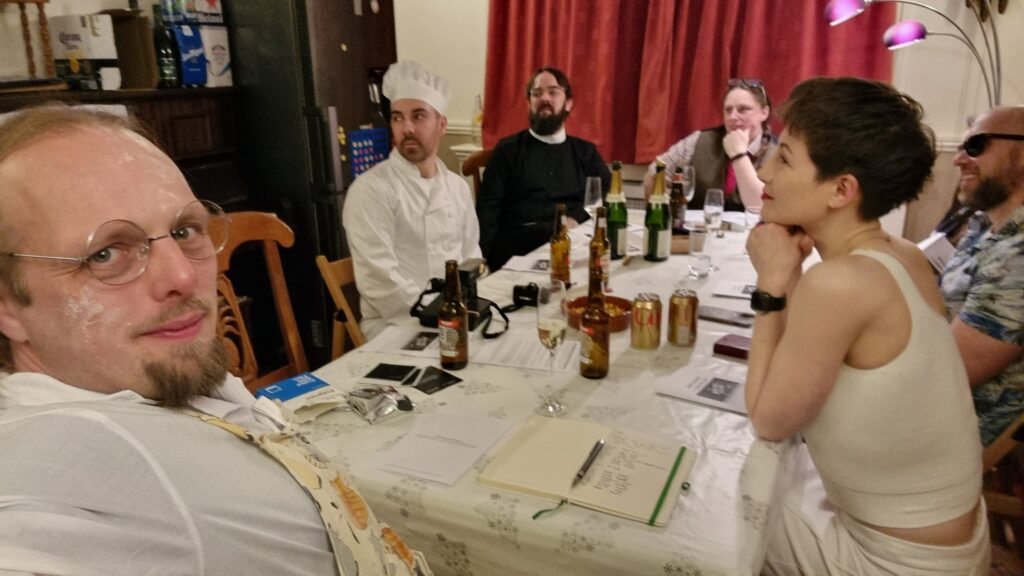
The writing was good overall: I especially appreciated the use of a true crime podcast as a framing device (expertly delivered thanks to Rory‘s radio voice). It was also pleasing to see, in hindsight, how the story had been assembled such that any character could be the murderer, but only one would give away a crucial clue. The downside of the format is pretty obvious, though: knowing what the mechanic is, a detective only needs to look at each piece of evidence that appears and look for a connection with each statement given by every other player, ruling out any “red herring” pairings that connect to every other player (as is common with just about the entire genre, all of the suspects had viable motives: only means and opportunity may vary).
It worked very well, but I wonder if – now the formula’s understood by us – a second set in a similar style wouldn’t be as successful.
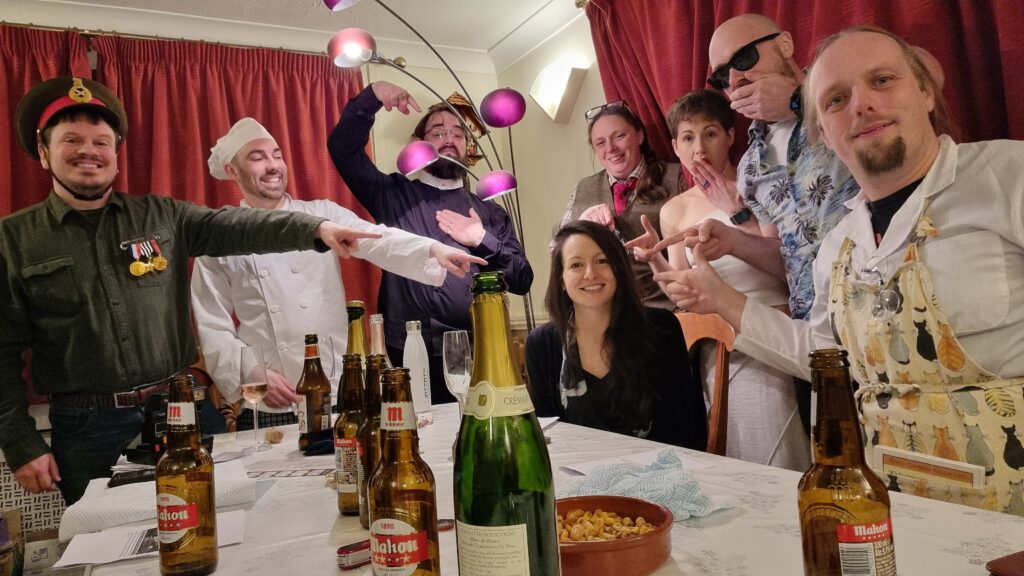
That said, nobody correctly fingered the murderer this time around. Maybe we’re out of practice? Or maybe the quality of the hints in such a wide-open and dynamic murderer-selection mechanic is less-solid than we’re used to? It’s hard to say: I’d certainly give another D’Avekki a go to find out.
This checkin to GC8W7QW Forgotten Bridge reflects a geocaching.com log entry. See more of Dan's cache logs.
Out on a walk with the dog along the footpath nearby I elected to drop in on this cache for routine maintenance. But as I approached the GZ I learned that the footbridge that provided this cache with its home clearly wasn’t as “forgotten” as I’d thought! The council have been up here again and rather than just signing the log as they did last time they were on a mission to replace the entire bridge!
When they did this with the bridge that hosted GC90RH3 they gave me enough notice to remove the cache, but not this time: by the time the geopup and I discovered the “new” bridge the cache container was long gone. (It was a modified ammo can, so I might reach out and see if they happened to retrieve it during the demolition and can give it back!)
Ah well; it was a fun cache while it lasted.

Beginning to prepare/test my costume for an upcoming murder mystery party, I glanced into the mirror and briefly didn’t recognise myself. Glasses can do so much to change your face shape!
Hasbro seem to be rolling up a new character. Maybe this’ll help them.
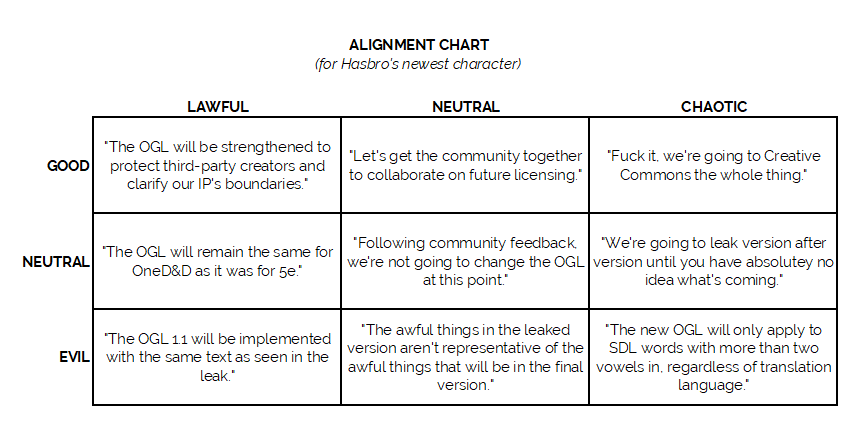
It all started when I saw no-ht.ml, Terence Eden‘s hilarious response to Salma Alam-Naylor‘s excellent HTML is all you need to make a website. The latter is an argument against both the silly amount of JavaScript with which websites routinely burden their users, but also even against depending on CSS. As a fan of CSS Naked Day and a firm believer in using JS only for progressive enhancement, I’m obviously in favour.
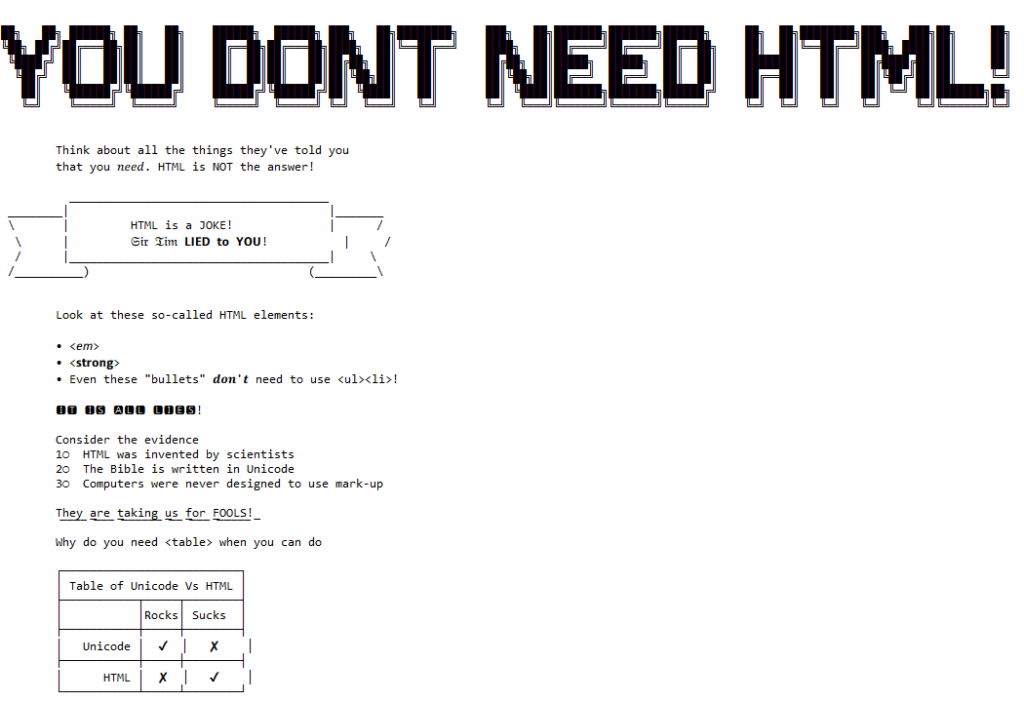
Terence’s site works by delivering a document with a
claimed MIME type of text/html, but which contains only the (invalid) “HTML” code
<!doctype UNICODE><meta charset="UTF-8"><plaintext> (to work around browsers’ wish to treat the page as HTML). This is followed by a block of UTF-8 plain text making use of spacing
and emoji to illustrate and decorate the content. It’s frankly very silly, and I love it.1
I think it’s possible to go one step further, though, and create a web page with no code whatsoever. That is, one that you can read as if it were a regular web page, but where
using View Source or e.g. downloading the page with curl will show you… nothing.
I present: The Page With No Code! (It’ll probably only work if you’re using Firefox, for reasons that will become apparent later.)
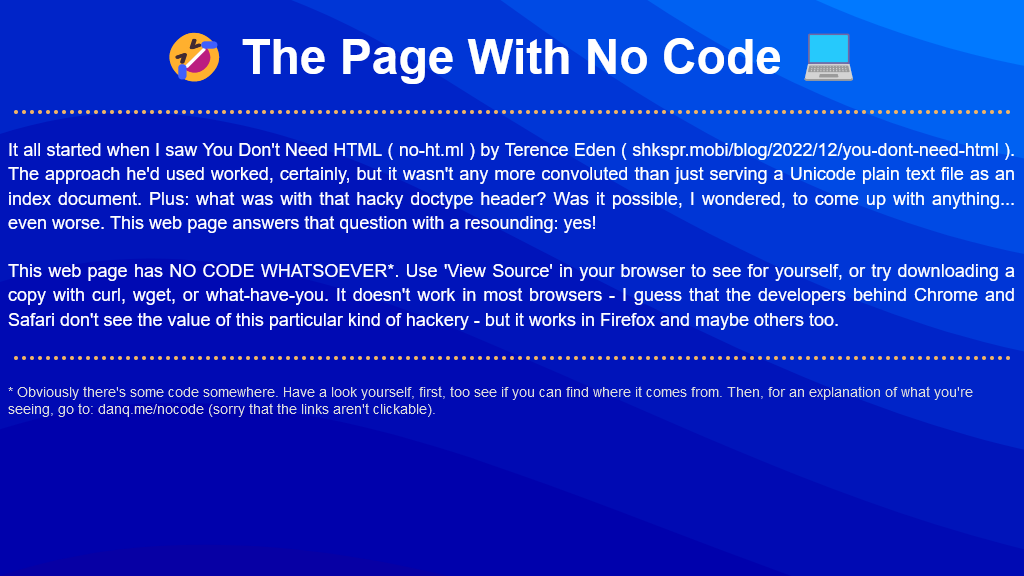
Once you’ve had a look for yourself and had a chance to form an opinion, here’s an explanation of the black magic that makes this atrocity possible:
Content-Type: text/html. Your browser interprets a completely-blank page as faulty and corrects it to a functionally-blank
minimal HTML page: <html><head></head><body></body></html>.
<body> and <html> elements can be styled with CSS; this includes the ability to add
content: ::before and ::after each
element. If only we could load a stylesheet then content injection is possible.
Link: HTTP header – to deliver a CSS payload (this, unfortunately, only works in Firefox). To further obfuscate what’s happening and remove the need for a round-trip, this is encoded
as a data: URI.
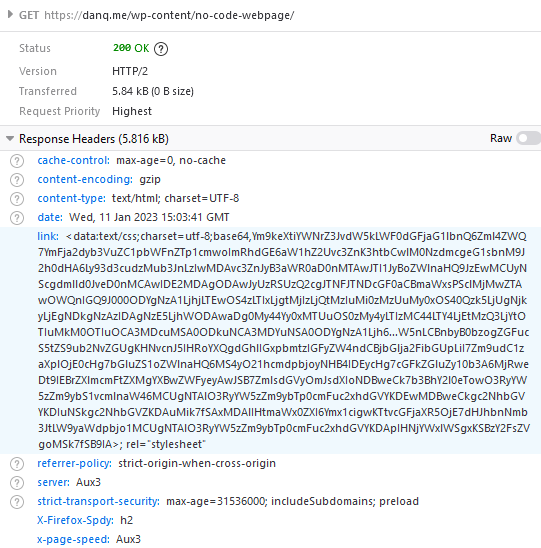
This is one of the most disgusting things I’ve ever coded, and that’s saying a lot. I’m so proud of myself. You can view the code I used to generate this awful thing on Github.
My server-side implementation of this broke in 2023 after I upgraded Nginx; my new version doesn’t support the super-long Link: header needed
to make this hack work, so I’ve updated the page to use the Link: to reference the CSS file rather than embed it via a data URI. It’s not as cool, but it at least means you can
still see the page. Thanks to Thomas Bradshaw for pointing out the problem.
1 My first reaction was “why not just deliver something with Content-Type:
text/plain; charset=utf-8 and dispense with the invalid code, but perhaps that’s just me overthinking the non-existent problem.
This is a repost promoting content originally published elsewhere. See more things Dan's reposted.
The SMBC comic that came out this weekend was perhaps the best birthday present the Internet could provide.
This checkin to GC4ZAJ2 HMS Belfast reflects a geocaching.com log entry. See more of Dan's cache logs.
A quick find by the eldest child on our way to visit the HMS Belfast. TFTC!

This checkin to GC4ZMV4 Tower Bridge TB HOTEL reflects a geocaching.com log entry. See more of Dan's cache logs.
A quick morning expedition with the kids on the way to visit HMS Belfast. Took the ghost TB (didn’t see any others); we’ll find it somewhere to live in Oxfordshire next week! TFTC.
Following their security incident last month, many users of LastPass are in the process of cycling their security credentials for many of their accounts1. I don’t use LastPass2, but I’ve had ocassion to cycle credentials before, so I appreciate the pain that people are going through.
It’s not just passwords, though: it may well be your “security question” answers you need to rotate too. Your passwords quickly become worthless if an attacker can guess the answers to your “security questions” at services that use them. If you’re using a password safe anyway, you should either:
In the latter case, you’re probably storing your security answers in a password safe5. If the password safe they’re stored in is compromised, you need to change the answers to those security questions in order to secure the account.
This leads to the unusual situation where you can need to call up your bank and say: “Hi, I’d like to change my mother’s maiden name.” (Or, I suppose, father’s middle name, first pet’s name, place of birth, or whatever.) Banks in particular are prone to disallowing you from changing your security answers over the Internet, but all kinds of other businesses can also make this process hard… presumably because a well-meaning software engineer couldn’t conceive of any reason that a user might want to.
I sometimes use a pronouncable password generator to produce fake names for security question answers. And I’ll tell you what: I get some bemused reactions when I say things like “I’d like to change my mother’s maiden name from Tuyiborhooniplashon to Mewgofartablejuki.”
But at least it forestalls them asking me “So why did you change your surname to ‘Q’?”
1 If you use LastPass, you should absolutely plan to do this. IMHO, LastPass’s reassurances about the difficulty in cracking the encryption on the leaked data is a gross exaggeration. I’m not saying you need to panic – so long as your master password is reasonably-long and globally-unique – but perhaps cycle all your credentials during 2023. Oh, and don’t rely on your second factor: it doesn’t help with this particular incident.
2 I used to use LastPass, until around 2016, and I still think it’s a good choice for many people, but nowadays I carry an encrypted KeePassXC password safe on a pendrive (with an automated backup onto an encrypted partition on our household NAS). This gives me some security and personalisation benefits, at the expense of only a little convenience.
3 If you’re confident that you could never lose your password (or rather: that you could never lose your password without also losing the security question answers because you would store them in the same place!), there’s no value in security questions, and the best thing you can do might be to render them unusable.
4 If you’re dealing with a service that uses the security questions in a misguided effort to treat them as a second factor, or that uses them for authentication when talking to them on the telephone, you’ll need to have usable answers to the questions for when they come up.
5 You can, of course, use a different password safe for your randomly-generatred security question answers than you would for the password itself; perhaps a more-secure-but-less-convenient one; e.g. an encrypted pendrive kept in your fire safe?
This checkin to geohash 2023-01-02 51 -1 reflects a geohashing expedition. See more of Dan's hash logs.
Muswell Hill, Piddington, Oxfordshire
I bundled the dog into the car and drove out to Piddington, a couple of kilometres North of the hashpoint. Cherwell Council advertise a circular walk that seems to circle from the village (which looked like a good place to park) up to Muswell Hill, the summit of which is near the hashpoint.
She and I walked through Piddington, past the church, and up onto the path. A soggy kilometre or so later we quickly discovered that this was going to be more-challenging than I’d anticipated. We quickly got bogged down in a flooded field and needed to double-back. With my socks already soaking wet and the dog in a similar condition, we found a different route that looped around the entire hill and through an alpaca farm (or were they llamas?), then we worked our way up the South face of the hill, over the summit, and down to the hashpoint. We got there at 11:00 UTC, took a quick look around and pulled the closest thing a dog can manage to a silly grin, and then hacked our way back (by road) to Piddington for the drive home and some dry clothes.
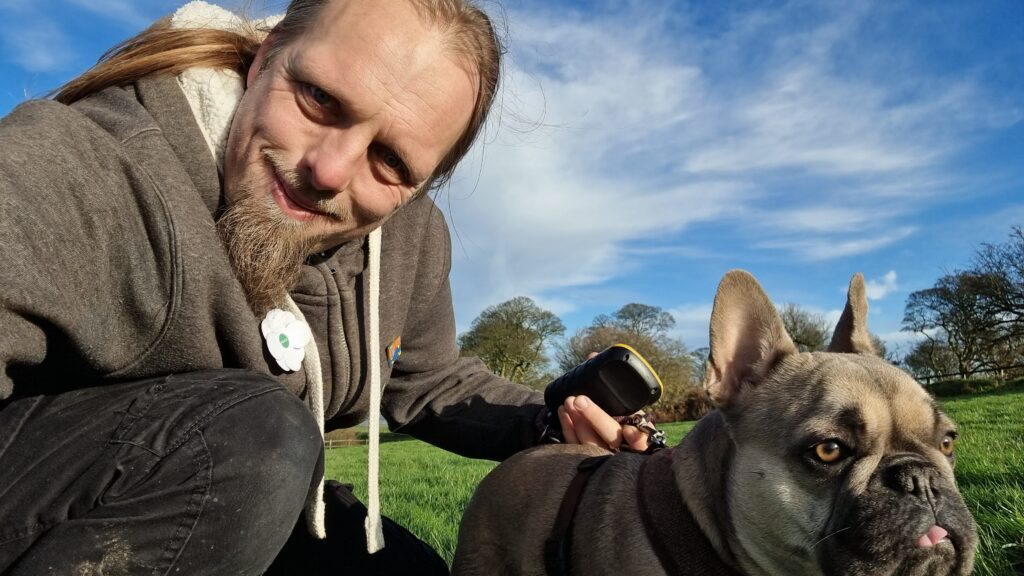
Also available on YouTube.
This checkin to GC9GKJA A Fine Pair # 1625 ~ Eynsham reflects a geocaching.com log entry. See more of Dan's cache logs.
Dropped by while cycling in the vicinity to replace the log book in the cache container. Hopefully this one will survive a little longer!
